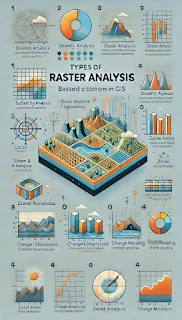Raster analysis is a powerful spatial analysis technique used in GIS to process and interpret grid-based datasets. It is widely applied in fields such as land cover classification, terrain modeling, hydrological studies, environmental monitoring, and spatial decision-making.
How Raster Analysis Works
Raster data is stored in a grid format where each cell (or pixel) represents a specific geographic location and contains a single value. The value can represent elevation, temperature, land cover type, or any other spatially continuous variable.
1. Spatial Resolution
- The size of each cell in a raster dataset determines the level of detail.
- Example: A 30m resolution DEM (Digital Elevation Model) means each cell represents a 30m × 30m area.
2. Extent
- The geographic area covered by a raster dataset.
- Example: A raster covering an entire country will have a larger extent than one covering a single city.
3. Cell Values and Data Types
- Continuous Data: Represents smoothly varying phenomena (e.g., elevation, temperature, precipitation).
- Categorical (Discrete) Data: Represents distinct classes (e.g., land use types, soil types).
Types of Raster Analysis in GIS
1. Overlay Analysis
Combines multiple raster layers to identify spatial relationships.
- Example: Identifying flood-prone areas by overlaying elevation, rainfall, and land use rasters.
2. Suitability Analysis
Determines the best location for a specific activity based on multiple criteria.
- Example: Finding a suitable site for a wind farm using layers like wind speed, land use, and proximity to roads.
3. Slope Analysis
Calculates the steepness of terrain from a DEM.
- Example: Identifying areas with slopes greater than 30° for landslide risk assessment.
4. Aspect Analysis
Determines the direction a slope is facing.
- Example: Finding south-facing slopes suitable for solar panel installation.
5. Distance Analysis
Measures the distance from a given feature.
- Example: Mapping areas within 1 km of a river for ecological conservation.
6. Zonal Statistics
Summarizes raster values within defined zones (e.g., administrative boundaries).
- Example: Calculating average rainfall within different watersheds.
7. Image Classification
Assigns land cover types to satellite images using supervised or unsupervised classification techniques.
- Example: Classifying Sentinel-2 imagery into urban, forest, water, and agriculture classes.
8. Change Detection
Identifies changes in land cover or other raster datasets over time.
- Example: Analyzing deforestation by comparing Landsat images from 2000 and 2020.
9. Terrain Analysis
Uses DEMs to derive hydrological and topographical features.
- Example: Identifying valleys, ridges, and watershed boundaries.
10. Surface Modeling
Creates interpolated surfaces from point data.
- Example: Generating a temperature surface from scattered weather station data.
Analysis Types Based on Cell Interactions
1. Local Operations (Per-Cell Analysis)
- Each cell is analyzed independently without considering neighbors.
- Example: Applying a mathematical function to all cells in a raster (e.g., converting elevation from meters to feet).
2. Neighborhood Operations (Focal Analysis)
- A cell's value is determined based on surrounding cells.
- Example: Applying a moving window filter (e.g., smoothing an elevation raster using a 3x3 mean filter).
3. Zonal Operations
- Groups of cells belonging to the same zone are analyzed collectively.
- Example: Calculating average elevation within different land use zones.
4. Global Operations
- The entire raster dataset is used to compute an output.
- Example: Calculating flow direction for an entire watershed.

Comments
Post a Comment